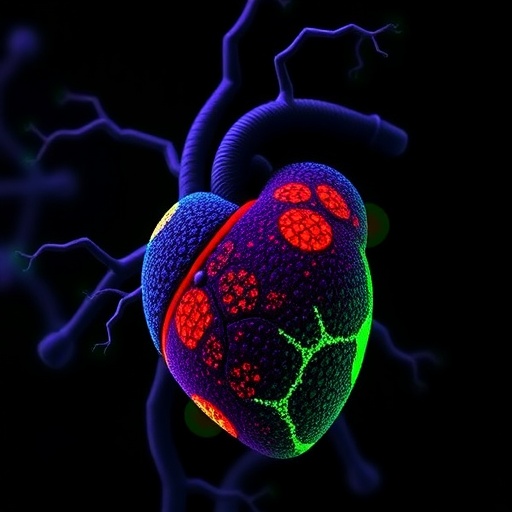In a groundbreaking study published in Nature Communications, researchers have unveiled a critical molecular mechanism underpinning cardiac homeostasis, shedding new light on the intricate regulation of heart function at the cellular level. The team led by Yu, Duan, and Lou has identified a long non-coding RNA (lncRNA), designated Cpat, which plays an indispensable role in maintaining mitochondrial integrity and energy metabolism within cardiomyocytes. This revelation not only deepens our understanding of cardiac biology but also opens promising avenues for therapeutic strategies targeting heart diseases rooted in mitochondrial dysfunction.
The heart’s relentless demand for energy hinges on mitochondrial efficiency and metabolic homeostasis. Cardiomyocytes, the beating cells of the heart, rely heavily on their mitochondria to generate adenosine triphosphate (ATP), the cellular energy currency, through oxidative phosphorylation. However, the precise molecular regulators coordinating mitochondrial function in the heart remain only partially understood. LncRNAs, once dismissed as transcriptional noise, have emerged as potent regulators of gene expression and cellular metabolism. In this study, the researchers focused on Cpat, a cardiomyocyte-specific lncRNA, hypothesizing its involvement in mitochondrial dynamics.
Using a combination of transcriptomic analyses and functional assays, the team first characterized the expression pattern of Cpat in cardiac tissue. They observed that Cpat is not only abundantly expressed in healthy cardiomyocytes but its levels markedly decrease in models of cardiac stress and failure. This downregulation hinted at a potential protective role of Cpat in heart function. Intriguingly, loss-of-function experiments showed that silencing Cpat precipitated drastic impairments in mitochondrial morphology and reduced ATP production, emphasizing the lncRNA’s critical contribution to mitochondrial bioenergetics.
Delving deeper into the molecular mechanisms, the study unveiled that Cpat exerts its effects by modulating the post-translational acetylation of citrate synthase (CS), a pivotal enzyme in the tricarboxylic acid (TCA) cycle. Acetylation of CS is a reversible modification influencing its enzymatic activity, and aberrant acetylation can significantly disrupt cellular metabolism. Through RNA immunoprecipitation and acetylation assays, the authors demonstrated that Cpat physically associates with CS, effectively targeting it to regulate its acetylation status. This interaction preserved CS activity, ensuring optimal flux through the TCA cycle and sustained energy production.
The researchers employed sophisticated in vivo models, including genetically engineered mice deficient in Cpat specifically in cardiomyocytes. These animals exhibited profound cardiac dysfunction, characterized by diminished ejection fraction and overt signs of heart failure. Mitochondrial examination revealed fragmented and swollen organelles with impaired respiratory capacity. Notably, restoring Cpat levels in these models via gene therapy restored mitochondrial function and significantly improved cardiac performance, underscoring Cpat’s therapeutic potential.
One of the most striking aspects of this study is the elucidation of how lncRNAs can directly modulate the acetylation of metabolic enzymes. While protein acetylation is predominantly governed by the balance of acetyltransferases and deacetylases, the finding that a non-coding RNA can influence this modification challenges existing paradigms. Cpat appears to act as a molecular scaffold or guide, directing specific acetylation events on citrate synthase, which adds a new layer of regulatory complexity in cardiometabolic control and exemplifies the multifaceted roles of lncRNAs in cellular physiology.
The implications of this discovery extend beyond basic science; mitochondrial dysfunction is a hallmark of numerous cardiac pathologies, including ischemic heart disease, diabetic cardiomyopathy, and dilated cardiomyopathy. Therapeutic strategies aimed at stabilizing mitochondrial metabolism could therefore revolutionize treatment paradigms. The identification of Cpat as a key regulator offers a novel target for drug development, with the potential to fine-tune mitochondrial enzyme activity and improve cardiac resilience under stress.
Furthermore, the study highlights the importance of epigenetic and post-translational modifications in cardiac metabolism regulation, urging the scientific community to explore non-coding RNAs as critical modulators rather than passive genomic elements. Such insights could lead to a new class of RNA-based therapeutics designed to manipulate specific protein modifications and restore metabolic balance in diseased hearts, providing precision medicine approaches for cardiovascular disorders.
In addition to mitochondrial effects, Cpat was found to influence the broader cardiac transcriptome, potentially via interaction networks extending beyond citrate synthase. Transcriptomic profiling revealed alterations in genes involved in oxidative stress responses, calcium signaling, and mitochondrial biogenesis upon Cpat depletion. These findings suggest that Cpat may serve as a central hub integrating metabolic and signaling pathways crucial for cardiomyocyte adaptability and survival.
Importantly, the study utilized cutting-edge technologies, including CRISPR-based gene editing, advanced microscopy for mitochondrial imaging, and mass spectrometry to analyze protein acetylation patterns with unprecedented resolution. These technological innovations allowed the team to dissect the delicate interplay between RNA molecules and protein modifications within the dynamic intracellular environment, setting new standards for molecular cardiology research.
The identification of Cpat’s role also raises fascinating questions about the evolutionary conservation of lncRNA-mediated regulation of metabolism. Comparative analyses hinted that functional analogs of Cpat may exist across mammalian species, suggesting that lncRNA-dependent control of mitochondrial enzymes is an evolutionarily conserved mechanism ensuring cardiac energy homeostasis. Future research may focus on cross-species validation and exploring how such regulatory circuits evolved to meet the high-energy demands of the vertebrate heart.
Moreover, the translational potential of Cpat-focused therapy is bolstered by the demonstration that synthetic mimics or gene therapy vectors can restore mitochondrial function in preclinical models. This opens the possibility of developing clinicians’ tools to treat heart failure patients with impaired mitochondrial metabolism by harnessing the molecular machinery governed by lncRNAs, potentially improving survival and quality of life.
The work by Yu and colleagues also emphasizes the necessity of incorporating lncRNA research into the broader framework of cardiovascular medicine, an area traditionally dominated by protein-centric studies. As the heart is an organ exquisitely sensitive to metabolic perturbations, understanding how non-coding RNAs regulate key metabolic enzymes provides a fresh conceptual lens through which heart disease mechanisms can be examined and targeted.
While this study provides compelling evidence of Cpat’s critical function, questions remain about the exact structural basis of its interaction with citrate synthase and whether other mitochondrial enzymes are similarly regulated by lncRNAs. Detailed structural biology investigations and expanded proteomic screens are warranted to fully uncover the spectrum of lncRNA-protein interactions in cardiac mitochondria and their physiological relevance.
In conclusion, the discovery of cardiomyocyte lncRNA Cpat as a guardian of mitochondrial function via targeted modulation of citrate synthase acetylation represents a significant leap forward in cardiac molecular biology. It underscores the intricate and previously underappreciated roles of non-coding RNAs in maintaining the delicate balance of energy metabolism fundamental to heart health. This landmark study not only enriches our scientific understanding but also paves the way for innovative RNA-based therapies against debilitating cardiovascular diseases.
Subject of Research: Cardiomyocyte long non-coding RNA and mitochondrial regulation.
Article Title: Cardiomyocyte lncRNA Cpat maintains cardiac homeostasis and mitochondria function by targeting citrate synthase acetylation.
Article References:
Yu, F., Duan, J., Lou, Z. et al. Cardiomyocyte lncRNA Cpat maintains cardiac homeostasis and mitochondria function by targeting citrate synthase acetylation. Nat Commun 16, 9022 (2025). https://doi.org/10.1038/s41467-025-64072-z
Image Credits: AI Generated
Tags: cardiac homeostasis mechanismscardiac mitochondrial regulationCardiomyocyte lncRNA Cpatenergy metabolism in cardiomyocytesgene expression regulation by lncRNAheart function molecular mechanismslong non-coding RNA in heart healthmitochondrial dysfunction and heart diseasemitochondrial integrity in cardiac cellsoxidative phosphorylation in cardiomyocytestherapeutic strategies for heart diseasetranscriptomic analysis in cardiac research





